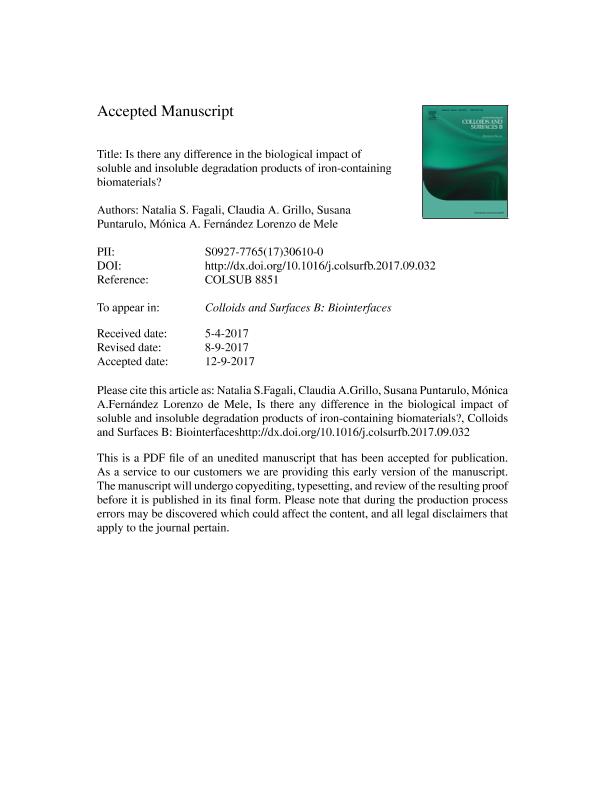Artículo
Is there any difference in the biological impact of soluble and insoluble degradation products of iron-containing biomaterials?
Fagali, Natalia Soledad ; Grillo, Claudia Alejandra
; Grillo, Claudia Alejandra ; Puntarulo, Susana Ángela
; Puntarulo, Susana Ángela ; Fernandez Lorenzo, Monica Alicia
; Fernandez Lorenzo, Monica Alicia
 ; Grillo, Claudia Alejandra
; Grillo, Claudia Alejandra ; Puntarulo, Susana Ángela
; Puntarulo, Susana Ángela ; Fernandez Lorenzo, Monica Alicia
; Fernandez Lorenzo, Monica Alicia
Fecha de publicación:
12/2017
Editorial:
Elsevier Science
Revista:
Colloids and Surfaces B: Biointerfaces
ISSN:
0927-7765
Idioma:
Inglés
Tipo de recurso:
Artículo publicado
Clasificación temática:
Resumen
The interactions that could be built between the biomaterials and tissue- microenvironments are very complex, especially in case of degradable metals that generate a broad variety of degradation products. The interfacial problems are particularly relevant for Fe-based materials that have been proposed for the development of biodegradable implants. The cell metabolism could be affected by the accumulation of insoluble Fe-containing degradation products that has been observed in vitro and in vivo as a coarse granular brownish material around the implant. However, the relative importance of each Fe-species (soluble and insoluble) on the cellular behavior of the surrounding cells, particularly on the generation of reactive species (RS), is not completely elucidated. The aim of this study is to evaluate the processes occurring at the Fe-biomaterial/cells interfacial region, and to discriminate the effects of soluble and insoluble corrosion products released by the bulk metal (Fe- microparticles (Fe0p) or Fe0 ring) on the adjacent cells, mainly in relation to RS generation. With this purpose Fe0p and Fe0 ring were incubated with fibroblast cells (BALB/c 3T3 line) for 24 and 48 h periods. Then different techniques were used, such as the dichlorofluorescein diacetate assay (DCFH2-DA) for detection of RS, acridine orange dye for cell viability, total protein content determinations, Prussian Blue staining and TEM observations. To individualize the effects of soluble and insoluble species, independent experiments with Fe3+-salts were performed. Overall data indicate that RS generation by cells exposed to the degradation products of Fe-based biomaterials is more dependent on the presence of insoluble products than on soluble Fe species.
Palabras clave:
Biodegradable
,
Biomaterials
,
Interface
,
Iron
,
Reactive Species
Archivos asociados
Licencia
Identificadores
Colecciones
Articulos(INIFTA)
Articulos de INST.DE INV.FISICOQUIMICAS TEORICAS Y APLIC.
Articulos de INST.DE INV.FISICOQUIMICAS TEORICAS Y APLIC.
Citación
Fagali, Natalia Soledad; Grillo, Claudia Alejandra; Puntarulo, Susana Ángela; Fernandez Lorenzo, Monica Alicia; Is there any difference in the biological impact of soluble and insoluble degradation products of iron-containing biomaterials?; Elsevier Science; Colloids and Surfaces B: Biointerfaces; 160; 12-2017; 238-246
Compartir
Altmétricas



